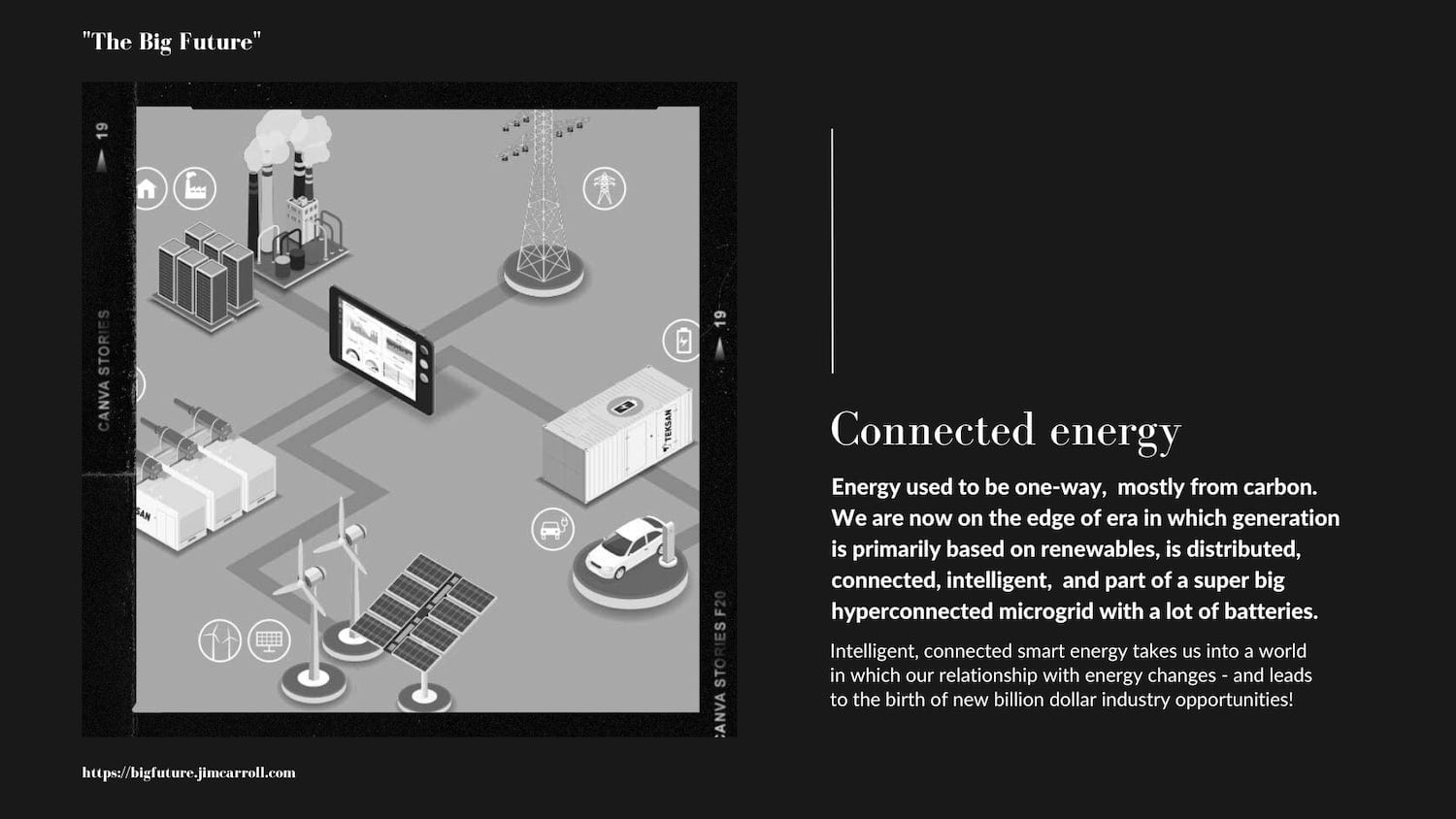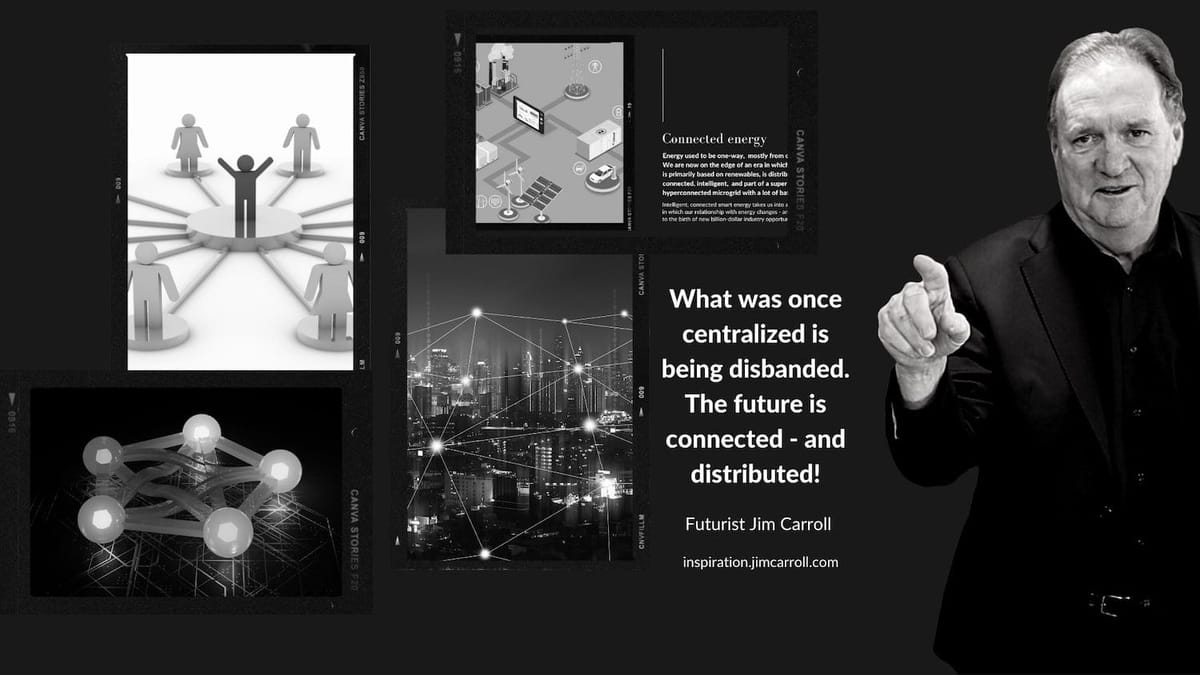I released trend #2 of my BIG Future series yesterday on Connected Energy. I'll share parts of it below in case you are not following. But the essence of the trend is this:
Energy in our electrical system used to be one-way and was mostly from carbon.
We are now on the edge of an era in which generation is primarily based on renewables, is distributed, connected, intelligent, and part of a super big hyperconnected microgrid with a lot of batteries. Intelligent, connected smart energy takes us into a world in which our relationship with energy changes - and leads to the birth of new billion-dollar industry opportunities!
That's a significant move in which the future of the energy system is essentially moving from a system that is centralized to one that is distributed - and that's a massive change full of opportunity.
But it's not happening just with energy but with other industries and technologies - the impact of 3d printing, for example, means that we might see the emergence of a more distributed manufacturing model.
It's also happening in the world of social media. While Twitter has been in the news much as of late, and there has been a lot of news about other social networks and their abuse - i.e. algorithms designed to show you material that will mostly enrage you - there has been a significant initiative on the sidelines for quite some time that distributes the idea and architecture of the social network. For quite some time, a grassroots initiative known as the FediVerse has been quietly building this model.
The result is a presence of a number of 'distributed networks' that provide a possible future for social media, and I'm actively participating. Mastodon is the best known - it's a distributed service organized around the protocols of the Fediverse (known as ActivityPub) that has the most chance of displacing much of Twitter. But there are other distributed components as well - PeerTube (Youtube), Friendica (Facebook), Pixelfed (Instagram), and others. In each case, there isn't one big, centralized system or network owner as in the case of the big social networks of today - instead, anyone can 'host' their own server to participate in the network. And through the magic of the ActivityPub protocol, you can share and follow other people online just as you would on the other networks.
And it's a wonderful place to be - I'm finding my Mastodon 'feed' to be powerfully engaging, full of people with unique ideas, initiative, and concepts - and of a very diverse background. In my case, I run my own Mastodon 'instance' over at https;//futurist.info, and I'm known on the network as @jimcarroll@futurist.info.
People can follow me there, just as they might have followed me on Twitter (which I no longer use). In my case, I'm on a 'single user instance' - I set up my own Mastodon server, just for myself, because it lets me put myself under my 'futurist' brand. Other instances support hundreds or thousands or a few cases, hundreds of thousands of people. Mastodon as of this moment is about 9 1/2 million people strong. My little 'instance' talks to hundreds of other 'instances' to share my posts and to pull in posts of those I follow. And it just ... works.
In this case, the future of social media might be moving from a 'centralized' to a 'distributed' model as many people are sick and tired of the owners of some (Musk), the information abuse (Facebook), the controversy (TikTok), much of which includes an algorithm over what you see (in the case of Twiter, more racist and right-wing hate)l. As well, you have to be content with advertising, tracking, privacy invasions, abuse and so much more. In the distributed network there is none of this, as the architecture and social norms really don't permit it.
As one well-known person stated, the future is moving from 'products' (Facebook, Instagram, etc) to protocols (ActivityPub.)
This is a BIG change.
That's but one example of a distributed future. It's happening with energy (below) and other industries. For a long time, we've been constructing a future that places everything in one central location but have realized that there are weaknesses to this approach. It makes sense to move from 'centralized' to 'distributed' - and this is a BIG trend.
---
Connected Energy
Energy in our electrical system used to be one-way and was mostly from carbon.
We are now on the edge of an era in which generation is primarily based on renewables, is distributed, connected, intelligent, and part of a super big hyperconnected microgrid with a lot of batteries. Intelligent, connected smart energy takes us into a world in which our relationship with energy changes - and leads to the birth of new billion-dollar industry opportunities!

What's happening?
Essentially, we are building a new energy grid, launching new industries, changing entire mobility platforms (automotive and trucking), and setting a path to a cleaner energy future. Much of this is currently happening in isolation, but over the decade to come, a lot of connectivity of these disparate platforms and trends is going to occur. It's already underway as smart innovators build out a fascinating new future.
In a nutshell:
- carbon is over as solar, wind and renewable energy come to dominate our future
- commercial, industrial, and residential properties are going to see the arrival of more battery storage technology to store this energy, smoothing out the dips and spurts that come with this generation
- most new cars and trucks will be electric within a decade as the era of gasoline and diesel energy comes to an end
- the batteries in those cars and trucks will come to be a part of the energy storage solution in these locations
- on top of that, most homes are getting smart appliances with the potential for connectivity and better management of their energy usage
- at the same time, factories and industrial facilities are getting a lot of interconnected devices through iiOT (Industrial Internet of Things) technology that also allows for intelligent energy management
- the home thermostat, which has gained intelligence through devices like the Nest and ecobee thermostats, is about to take on a larger role in managing this internal home energy grid
- at the same time, sophisticated platforms for energy management in industrial, commercial, and factory locations will do the same thing
- all of this provides a little energy grid within the home and in these industries/commercial facilities, providing a form of energy independence
- and a key component is that any excess energy within this grid will be fed back out into the large utility grid to provide it with additional power, transitioning it from a one-way to a two-way systems
- this grid connectivity also provides the opportunity for local community microgrids - you've got a grid, I've got a grid - let's connect our grids
I told this story when booked by the CEO of the California energy giant PG&E several years ago:
What it represents
Within this trend are several massive opportunities. I've often liked to point out that in many industries, this is the big disruption:
Companies that do not yet exist will build products not yet conceived, with materials not yet in existence, using methodologies not yet developed - and these will be sold to consumers who do not yet know that these new products and services will become a critical part of their life.
It's in that type of thinking that this new industry is unfolding.
Futurist Jim Carroll spent an hour the other day on his treadmill, due to the cold, and spent that hour reading posts on his feed on Mastodon. He never got bored, never got mad, and never saw any hate. In that way, the future is Mastodon, clearly not Twitter.

